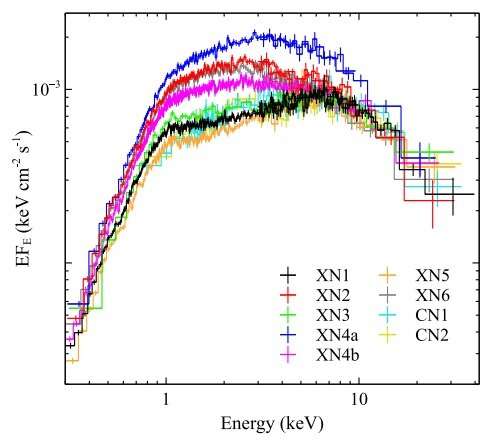The broadband spectral evolution displayed by NGC 1313 X-1. Credit: Walton et al., 2019.
An ultraluminous X-ray source (ULX) in the NGC 1313 galaxy, known as NGC 1313 X-1, showcases an unusual X-ray spectral variability, according to a new study recently conducted by an international team of astronomers. The finding is reported in a paper published November 21 on arXiv.org.
ULXs are point sources in the sky that are so bright in X-rays that each emits more radiation than 1 million suns emit at all wavelengths. They are less luminous than active galactic nuclei, but more consistently luminous than any known stellar process. Although numerous studies of ULXs have been conducted, the basic nature of these sources still remains unsolved.
Located some 15 million light years away, NGC 1313 is a barred spiral galaxy about half the size of the Milky Way. It hosts an ultraluminous X-ray source, designated NGC 1313 X-1, classified as an archetypal ULX—an off-nuclear X-ray source radiating in excess of 1.0 duodecillion erg/s.
NGC 1313 X-1 was a target of a coordinated X-ray observing program conducted in 2017. The researchers studied this source using ESA's XMM-Newton spacecraft, together with NASA's Chandra and NuSTAR space telescopes, in order to investigate mainly the evolution of its broadband continuum emission. Results of this monitoring campaign, presented recently by a group of researchers led by Dominic Walton of the University of Cambridge, U.K., show that this object exhibits an unusual spectral variability in X-rays.
"We have presented results from the major coordinated X-ray observing program on the ULX NGC 1313 X-1 performed in 2017, combining XMM-Newton, Chandra and NuSTAR, focusing on the evolution of the broadband (~0.3-30.0 keV) continuum emission," the astronomers wrote in the paper.
The observations detected a clear spectral X-ray variability in NGC 1313 X-1, more apparent at low energies (below 10 keV). The spectra show a more flat-topped profile at lower fluxes and become more centrally peaked at higher fluxes. While at about 3.0 keV, the fluxes vary by a factor of more than three, the variations at above 10 keV were observed as evidently less significant—by a factor of only 1.5.
The study also investigated the behavior of the two thermal components of NGC 1313 X-1, focusing on how they evolve in the luminosity-temperature plane. It was found that the hotter disc component showcases two distinct tracks in the luminosity-temperature plane, with larger emitting radii and lower temperatures seen at higher observed fluxes. What is surprising is that despite this anti-correlation, each of these tracks individually shows a positive luminosity-temperature relation.
Trying to explain the unusual variability and the observed evolution of thermal components of NGC 1313 X-1, the astronomers ponder several hypotheses, given that the nature of this system is not well understood.
"These include geometric changes (precession of the flow, beaming of the radiation, obscuration of the inner regions), as well as atmospheric effects (color correction in the disc atmosphere, down-scattering in the wind)," the authors of the paper concluded.
More information: The Unusual Broadband X-ray Spectral Variability of NGC 1313 X-1 seen with XMM-Newton, Chandra and NuSTAR, arXiv:1911.09622 [astro-ph.HE] arxiv.org/abs/1911.09622
© 2019 Science X Network
























